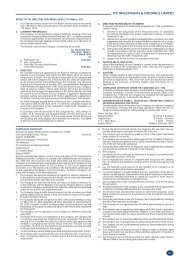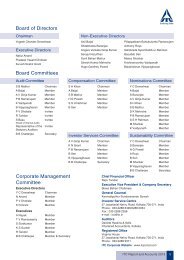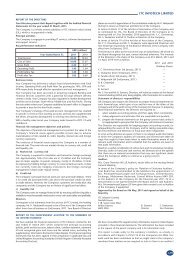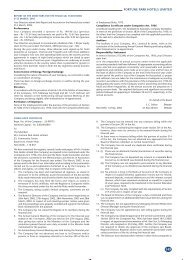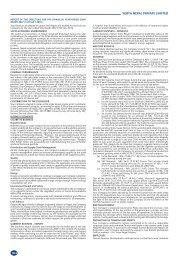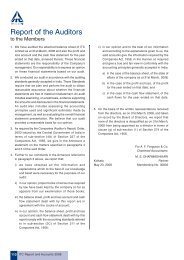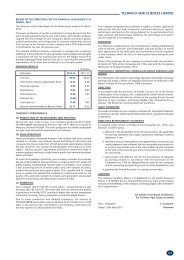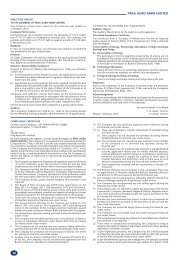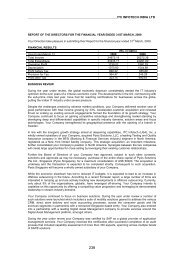SUBSIDIARY COMPANIES - ITC Ltd
SUBSIDIARY COMPANIES - ITC Ltd
SUBSIDIARY COMPANIES - ITC Ltd
You also want an ePaper? Increase the reach of your titles
YUMPU automatically turns print PDFs into web optimized ePapers that Google loves.
Deferred income tax liabilities are recognised for all taxable<br />
temporary differences except:<br />
• when the deferred income tax liability arises from the initial<br />
recognition of goodwill or of an asset or liability in a transaction<br />
that is not a business combination and that, at the time of the<br />
transaction, affects neither the accounting profit nor taxable profit<br />
or loss; or<br />
• when the taxable temporary difference is associated with investments<br />
in subsidiaries, associates or interests in joint ventures, and the<br />
timing of the reversal of the temporary difference can be controlled<br />
and it is probable that the temporary difference will not reverse<br />
in the foreseeable future.<br />
Deferred income tax assets are recognised for all deductible<br />
temporary differences, carry-forward of unused tax assets and<br />
unused tax losses, to the extent that it is probable that taxable<br />
profit will be available against which the deductible temporary<br />
differences and the carry-forward of unused tax credits and unused<br />
tax losses can be utilised, except:<br />
• when the deferred income tax asset relating to the deductible<br />
temporary difference arises from the initial recognition of an asset<br />
or liability in a transaction that is not a business combination and,<br />
at the time of the transaction, affects neither the accounting profit<br />
nor taxable profit or loss; or<br />
• when the deductible temporary difference is associated with<br />
investments in subsidiaries, associates or interests in joint ventures,<br />
in which case a deferred tax asset is only recognised to the extent<br />
that it is probable that the temporary difference will reverse in the<br />
foreseeable future and taxable profit will be available against which<br />
the temporary difference can be utilised.<br />
The carrying amount of deferred income tax assets is reviewed at<br />
each balance sheet date and reduced to the extent that it is no<br />
longer probable that sufficient taxable profit will be available to<br />
allow all or part of the deferred income tax asset to be utilised.<br />
Unrecognised deferred income tax assets are reassessed at each<br />
balance sheet date and are recognised to the extent that it has<br />
become probable that future taxable profit will allow the deferred<br />
tax asset to be recovered.<br />
Deferred income tax assets and liabilities are measured at the tax rates<br />
that are expected to apply to the year when the asset is realised or the<br />
liability is settled, based on tax rates (and tax laws) that have been<br />
enacted or substantively enacted at the balance sheet date.<br />
Income taxes relating to items recognised directly in equity are recognised<br />
in equity and not in profit or loss.<br />
Deferred tax assets and deferred tax liabilities are offset only if a legally<br />
enforceable right exists to set off current tax assets against current tax<br />
liabilities and the deferred tax assets and liabilities relate to the same<br />
taxable entity and the same taxation authority.<br />
TECHNICO PTY LIMITED<br />
(p) Other taxes<br />
Revenues, expenses and assets are recognised net of the amount of<br />
GST except:<br />
• when the GST incurred on a purchase of goods and services is not<br />
recoverable from the taxation authority, in which case the GST is<br />
recognised as part of the cost of acquisition of the asset or as part<br />
of the expense item as applicable; and<br />
• receivables and payables, which are stated with the amount of<br />
GST included.<br />
The net amount of GST recoverable from, or payable to, the taxation<br />
authority is included as part of receivables or payables in the balance<br />
sheet.<br />
Cash flows are included in the cash flow statement on a gross basis<br />
and the GST component of cash flows arising from investing and<br />
financing activities, which are recoverable from, or payable to, the<br />
taxation authority, are classified as operating cash flows.<br />
Commitments and contingencies are disclosed net of the amount of<br />
GST recoverable from, or payable to, the taxation authority.<br />
(q) Employee benefits<br />
(i) Wages, salaries and annual leave<br />
Liabilities for wages and salaries, including non-monetary benefits<br />
and annual leave expected to be settled within twelve months of<br />
the reporting date are recognised in other payables in respect of<br />
employees’ services up to the reporting date. They are measured<br />
at the amounts expected to be paid when the liabilities are settled.<br />
(ii) Long service leave<br />
The liability for long service leave is recognised in the provision<br />
for employee benefits and measured as the present value of<br />
expected future payments to be made in respect of services provided<br />
by employees up to the reporting date using the projected unit<br />
credit method. Consideration is given to expected future wage<br />
and salary levels, experience of employee departures, and periods<br />
of service. Expected future payments are discounted using market<br />
yields at the reporting date on national government bonds with<br />
terms to maturity and currencies that match, as closely as possible,<br />
the estimated future cash outflows.<br />
(r) Intangibles other than goodwill on acquisition<br />
Technology, patents and trademarks<br />
Intangibles include TECHNITUBER® technology of the company and<br />
trademarks and are considered to have finite lives, and are amortised<br />
over the useful lives and assessed for impairment whenever there is an<br />
indication that the intangible asset may be impaired. If benefit is no<br />
longer expected to be received, the asset will be written down to its<br />
net realisable value.<br />
(s) Comparatives<br />
When required by Accounting Standards, comparative figures have<br />
been adjusted to conform to changes in presentation for the current<br />
financial year.<br />
59




